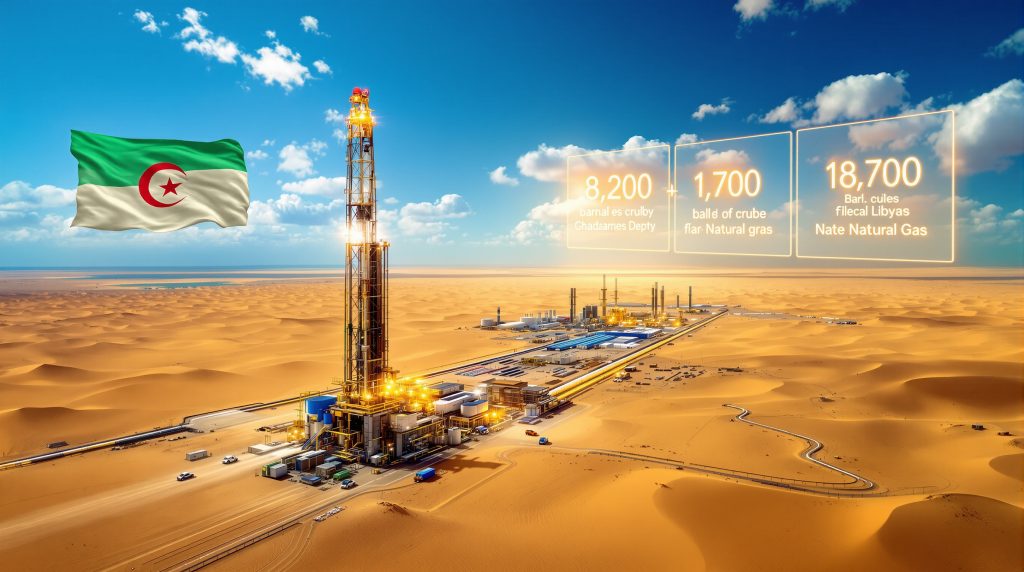What Makes the Ghadames Basin Critical for North African Energy Security?
The Ghadames Basin represents one of North Africa's most strategically important hydrocarbon provinces, spanning across Algeria, Libya, and Tunisia. This transboundary geological formation has emerged as a cornerstone for regional energy cooperation and security, particularly as North African nations seek to diversify their energy portfolios and strengthen cross-border partnerships. Furthermore, the Sonatrach oil gas drilling Libya Ghadames Basin operations demonstrate the potential for successful international collaboration in challenging environments.
Strategic Location at the Algeria-Libya Border
The basin's location along the Algeria-Libya frontier creates unique opportunities for joint exploration and production activities. Sonatrach oil gas drilling operations in this region benefit from established infrastructure networks that extend across both nations. The proximity to existing facilities, including connections to Algeria's extensive pipeline system, provides significant cost advantages for future development projects.
This strategic positioning allows for shared technical expertise and risk mitigation between the two countries. The cross-border nature of the basin enables coordinated exploration programs that can maximise resource recovery while minimise environmental impact through consolidated operations.
Geological Significance and Hydrocarbon Potential
The Ghadames Basin contains multiple productive geological formations, with proven hydrocarbon-bearing strata extending to considerable depths. The basin's geological structure includes:
- Paleozoic sedimentary sequences with excellent source rock characteristics
- Multiple reservoir levels providing diverse exploration targets
- Proven structural and stratigraphic traps supporting commercial discoveries
- Favourable thermal maturity for both oil and gas generation
Recent geological assessments indicate the basin contains significant untapped reserves, with exploration activities targeting formations at depths exceeding 8,000 feet. The diverse geological profile supports both conventional and unconventional resource development opportunities.
Cross-Border Energy Cooperation Framework
The bilateral framework governing Ghadames Basin operations exemplifies successful energy diplomacy in North Africa. This cooperation model includes:
- Joint venture structures for exploration and production activities
- Shared infrastructure development reducing capital expenditure requirements
- Coordinated regulatory oversight streamlining operational approvals
- Technology transfer agreements enhancing local technical capabilities
The framework has established precedents for similar cross-border energy projects throughout the region, contributing to broader North African energy integration initiatives.
Why Did Sonatrach Suspend Operations for Over a Decade?
The suspension of drilling activities in Libya Ghadames Basin operations stemmed from complex security and political challenges that fundamentally altered the operational landscape across the region. Understanding these factors provides crucial context for the significance of resumed exploration activities.
Security Challenges Following 2011 Political Upheaval
The 2011 Libyan civil war created unprecedented security risks for international energy operations throughout the country. Sonatrach faced mounting challenges including:
- Armed conflict in operational areas threatening personnel safety
- Infrastructure damage to existing facilities and transportation networks
- Breakdown of law enforcement in remote exploration regions
- Kidnapping risks for international technical staff
The company suspended operations in May 2014, reflecting the deteriorating security environment that made continued exploration activities untenable. This decision aligned with broader industry trends, as most international operators ceased or significantly reduced their Libyan operations during this period.
Impact on International Energy Investments
The operational suspension created a ripple effect across North African energy markets. Investment flows into the region declined significantly as international companies reassessed their risk exposure in politically unstable territories. The suspension affected:
- Technology transfer programs between Algerian and Libyan operations
- Regional supply chain networks serving cross-border projects
- Local employment opportunities in border communities
- Government revenue streams from joint venture arrangements
The extended suspension period also resulted in technical challenges, including well preservation requirements and equipment maintenance in harsh desert conditions without regular operational oversight.
Regional Stability Requirements for Exploration Activities
Energy companies operating in the Ghadames Basin require specific stability indicators before resuming major investments:
"Critical stability factors include sustained ceasefire agreements, functional government institutions capable of contract enforcement, secure transportation corridors for personnel and equipment, and predictable regulatory frameworks for long-term project planning."
The resumption of Sonatrach operations indicates these fundamental requirements have been sufficiently addressed to justify renewed exploration investments in the basin.
What Does the Resumed Drilling Operation Involve?
The renewed drilling campaign represents a carefully planned technical operation designed to complete previous exploration objectives while incorporating advanced drilling technologies developed during the suspension period.
Technical Specifications of Block 95/96 Exploration
The current drilling program focuses on completing wells previously suspended due to security concerns. Key technical parameters include:
| Operational Parameter | Specification |
|---|---|
| Target Depth | 8,440 feet (completion from 8,090 feet) |
| Distance from Wafa Field | 100 kilometres |
| Distance from Tripoli | 800 kilometres southwest |
| Block Location | Ghadames Basin Blocks 95/96 |
The drilling program targets specific geological formations identified in previous exploration phases. The additional 350 feet of planned drilling aims to reach potentially productive zones that remained unexplored due to the operational suspension.
Equipment and Methodology for Deep Basin Drilling
Modern drilling operations in the Ghadames Basin employ advanced technologies adapted for desert conditions and deep formation targets:
- High-temperature drilling mud systems engineered for extreme downhole conditions
- Advanced wellbore imaging technologies providing detailed geological characterisation
- Horizontal drilling capabilities maximising reservoir contact and production potential
- Remote monitoring systems enabling real-time operational oversight from secure locations
The equipment selection reflects lessons learned during the suspension period, with enhanced focus on rapid deployment capabilities and reduced surface footprint requirements. Moreover, these technological advances align with US natural gas trends towards more efficient extraction methods.
Timeline and Phases of Exploration Activities
The drilling program follows a phased approach designed to minimise risk while maximising geological information acquisition:
Phase 1: Well Completion (Current)
- Resume drilling from 8,090 to 8,440 feet depth
- Comprehensive geological logging and analysis
- Preliminary production testing if hydrocarbons encountered
Phase 2: Extended Testing
- Long-term production testing protocols
- Reservoir characterisation studies
- Economic assessment and development planning
Phase 3: Development Decision
- Commercial viability evaluation
- Infrastructure development planning
- Regulatory approvals for production operations
How Significant Are the Previous Discovery Results?
The 2013 discovery in the Ghadames Basin demonstrated the commercial potential that justified Sonatrach's return to the area despite security challenges and operational complexities.
2013 Field Discovery Performance Metrics
Initial production testing revealed encouraging hydrocarbon flows that supported continued exploration investment:
| Production Metric | Daily Capacity |
|---|---|
| Crude Oil Output | 8,200 barrels |
| Natural Gas Volume | 1,700 cubic metres |
These production rates, while preliminary, indicated reservoir characteristics suitable for commercial development. The dual hydrocarbon production capability provides operational flexibility and revenue diversification opportunities.
Geological Assessment and Reserve Potential
The 2013 discovery provided critical geological data supporting broader basin development strategies:
- Reservoir quality assessment confirmed adequate porosity and permeability
- Hydrocarbon migration patterns indicated larger regional accumulations
- Structural analysis identified additional exploration targets
- Completion effectiveness validated drilling and production techniques
Preliminary reserve estimates suggested the discovered accumulation represented only a portion of the basin's total hydrocarbon potential, encouraging continued exploration activities. This discovery pattern mirrors trends observed in global oil futures markets where new discoveries continue to impact pricing dynamics.
Comparative Analysis with Regional Fields
The Ghadames Basin discovery compares favourably with similar geological settings across North Africa:
Regional Production Comparison:
- Hassi Messaoud (Algeria): 350,000 barrels per day
- Wafa Field (Libya): 17,000 barrels per day
- Ghadames Discovery: 8,200 barrels per day (initial testing)
While significantly smaller than major regional producers, the discovery's production rates align with successful mid-tier developments in similar geological conditions, supporting commercial development potential.
What Role Does Libya's Political Landscape Play in Energy Development?
Libya's complex political environment creates both challenges and opportunities for international energy investments, with the current governmental framework providing cautious optimism for sector recovery.
Government of National Unity Investment Framework
The internationally recognised Government of National Unity has established investment protocols designed to attract international energy companies back to Libya:
- Streamlined approval processes for exploration and production permits
- Enhanced security provisions for international operations
- Flexible fiscal terms competitive with regional alternatives
- Infrastructure development commitments supporting operational requirements
The government launched a comprehensive oil and gas sector recovery plan in early 2025, backed by investments estimated between $3-4 billion, demonstrating commitment to sector revitalisation.
Eastern Administration Energy Policies
Libya's parallel administration in Benghazi, allied with Khalifa Haftar, controls significant portions of the country including major oil-producing regions. This administration has:
- Maintained separate energy policies sometimes conflicting with Tripoli-based decisions
- Controlled key infrastructure including ports and pipeline networks
- Negotiated independent agreements with international operators
- Received foreign backing from Russia and other international powers
The dual authority structure creates operational complexity but has not prevented the resumption of exploration activities in areas under unified oversight. These developments parallel the Alaska drilling policy shift where political changes have similarly impacted energy sector operations.
International Recognition and Regulatory Environment
International energy companies operating in Libya must navigate competing legal frameworks while maintaining compliance with international sanctions regimes:
- UN recognition of the Government of National Unity provides legal clarity
- European Union engagement supports investment protection frameworks
- African Union mediation facilitates conflict resolution mechanisms
- US sanctions considerations require careful compliance monitoring
The regulatory environment, while complex, provides sufficient legal framework for major international operators to resume selected operations.
How Does This Fit Libya's Broader Oil Sector Recovery Strategy?
The Sonatrach oil gas drilling Libya Ghadames Basin resumption represents one component of Libya's comprehensive strategy to restore oil production capacity and attract international investment after years of conflict-related disruption.
$3-4 Billion Investment Recovery Plan Details
Libya's ambitious recovery plan encompasses multiple strategic initiatives:
Infrastructure Rehabilitation:
- Pipeline network repairs and upgrades
- Port facility modernisation programs
- Power generation capacity expansion
- Transportation corridor security enhancement
Production Capacity Restoration:
- Brownfield development prioritisation
- Enhanced oil recovery implementation
- Gas monetisation project advancement
- Renewable energy integration planning
The investment framework prioritises projects with immediate production potential while building foundation for long-term capacity expansion. These developments reflect broader patterns in OPEC production impact decisions affecting global markets.
First Oil Bidding Round in 17 Years (April 2025)
Libya's return to international competitive bidding represents a watershed moment for the country's energy sector:
- Block offerings include both onshore and offshore opportunities
- Fiscal terms designed to compete with regional alternatives
- Technical requirements emphasising rapid development capabilities
- Local content provisions supporting domestic economic development
The bidding round attracted significant international interest, with major operators including ExxonMobil and Chevron participating in preliminary discussions.
International Operator Participation Trends
The pattern of international re-engagement reflects careful risk assessment and staged investment approaches:
Current Operator Activities:
- Eni: Northwest coast offshore exploration resumption
- Saipem: Gas monetisation project pre-qualification
- ExxonMobil: Development discussions for existing blocks
- Chevron: Production enhancement negotiations
This gradual re-engagement pattern allows operators to test operational conditions while building confidence in Libya's long-term stability prospects.
Which Other International Companies Are Re-entering Libya?
The resumption of international energy operations in Libya extends beyond Sonatrach oil gas drilling activities, encompassing multiple major operators implementing diverse strategic approaches to market re-entry.
Eni's Northwest Coast Offshore Exploration
Italian energy giant Eni has emerged as one of the most aggressive international operators in Libya's recovering energy sector:
- Offshore exploration resumption in early October 2025 along Libya's northwest coast
- Existing infrastructure leverage through historical Libyan operations
- Integrated development approach combining exploration with production enhancement
- Local partnership emphasis with National Oil Corporation collaboration
Eni's operational strategy emphasises rapid deployment of proven technologies while building local technical capabilities through comprehensive training programs. The company's return to Libya signals growing confidence in the country's operational environment.
ExxonMobil and Chevron Development Discussions
American energy majors have adopted measured approaches focusing on high-potential assets with established geological understanding:
ExxonMobil Strategic Focus:
- Existing block development optimisation
- Enhanced recovery technology implementation
- Regional infrastructure integration planning
- Local workforce development initiatives
Chevron Operational Priorities:
- Production capacity restoration in mature fields
- Technology transfer program establishment
- Supply chain localisation strategies
- Environmental compliance framework development
Both companies have emphasised brownfield development over greenfield exploration, reflecting risk management strategies appropriate for Libya's transitional political environment.
Saipem's Gas Monetisation Project Involvement
Italian engineering contractor Saipem has pre-qualified for structures and engineering projects supporting Libya's gas monetisation drive:
- LNG facility development engineering and construction services
- Pipeline infrastructure design and installation capabilities
- Offshore platform construction and installation expertise
- Project management services for integrated development programs
Saipem's involvement indicates growing confidence in Libya's ability to support complex, capital-intensive energy infrastructure projects requiring multi-year development timelines.
What Are Libya's Long-term Production Targets?
Libya has established ambitious production objectives designed to restore its position as a major global oil producer while developing previously untapped gas reserves for both domestic use and export markets.
2 Million Barrels Per Day Objective
Libya's production target of 2 million barrels per day represents a significant increase from current output levels and would restore the country to pre-2011 production capacity:
Production Pathway Analysis:
- Current production: Approximately 1.2 million barrels per day
- Target increase: 800,000 barrels per day additional capacity
- Timeline: Phased approach over 5-7 year period
- Investment requirement: Estimated $15-20 billion in development capital
Achieving this target requires coordinated development of both existing fields and new discoveries, supported by comprehensive infrastructure rehabilitation.
Africa's Largest Proven Oil Reserves (48 Billion Barrels)
Libya's substantial reserve base provides strong foundation for sustained long-term production:
| Reserve Category | Estimated Volume |
|---|---|
| Proven Oil Reserves | 48 billion barrels |
| Probable Reserves | 15 billion barrels |
| Natural Gas Reserves | 1.5 trillion cubic metres |
| Undiscovered Potential | 10-15 billion barrels |
These reserves rank Libya among the world's top ten countries by proven oil reserves, providing strategic importance for both regional and global energy security. However, reports from Sonatrach's renewed exploration activities indicate potential for discovering additional resources.
Brownfield Development vs. New Exploration Balance
Libya's production strategy emphasises brownfield development while maintaining commitment to exploration activities:
Brownfield Development Priorities:
- Enhanced oil recovery implementation in mature fields
- Infrastructure modernisation and capacity expansion
- Production optimisation through advanced technologies
- Operational efficiency improvements reducing unit costs
New Exploration Initiatives:
- Frontier basin evaluation including Ghadames Basin expansion
- Offshore exploration program development
- Unconventional resource assessment
- Cross-border cooperation opportunities
The balanced approach aims to achieve rapid production increases through brownfield development while building long-term sustainability through exploration success.
How Will Cross-Border Cooperation Impact Regional Energy Markets?
The Algeria-Libya energy partnership exemplified by Sonatrach Ghadames Basin operations represents a broader trend toward regional energy integration across North Africa.
Algeria-Libya Energy Partnership Benefits
The bilateral energy cooperation extends beyond individual projects to encompass strategic regional development:
- Infrastructure sharing reducing development costs for both countries
- Technical expertise exchange enhancing operational capabilities
- Risk diversification through portfolio effects across multiple projects
- Market access optimisation leveraging both countries' export infrastructure
This partnership model demonstrates potential for similar cooperation arrangements across other North African borders, particularly involving Tunisia, Egypt, and Morocco.
Mediterranean Gas Export Potential
Cross-border cooperation enhances both countries' ability to serve growing European gas demand:
Export Infrastructure Advantages:
- Trans-Mediterranean Pipeline connectivity through Algeria to Europe
- Greenstream Pipeline direct Libya-Italy gas transmission capability
- Proposed interconnection projects linking Libyan and Algerian systems
- LNG export facilities potential development through joint investment
The combined gas resources of Algeria and Libya position the partnership as a significant supplier to European markets seeking Russian energy alternatives. These developments align with the broader energy transition outlook affecting global markets.
European Energy Security Implications
North African energy cooperation directly impacts European energy security strategies:
- Supply diversification reducing dependence on single-source suppliers
- Transit route multiplication enhancing supply security resilience
- Price competitiveness through increased supplier competition
- Long-term contract availability providing planning certainty for European buyers
European energy policies increasingly recognise North African partnerships as strategic components of continental energy security frameworks.
What Challenges Could Affect Future Operations?
Despite positive developments surrounding Sonatrach operations resumption, significant challenges remain that could impact the sustainability and expansion of energy activities in Libya's Ghadames Basin.
Security Risk Assessment and Mitigation
Ongoing security concerns require comprehensive risk management frameworks:
Persistent Security Challenges:
- Regional terrorist group activity in remote border areas
- Armed militia presence in oil-producing regions
- Cross-border smuggling operations affecting operational security
- Periodic civil unrest in major population centres
Mitigation Strategies:
- Enhanced security protocols for international personnel
- Local security contractor partnerships
- Real-time threat monitoring systems
- Emergency evacuation capability maintenance
Energy companies must balance operational efficiency with security requirements, often resulting in higher operational costs and extended project timelines.
Infrastructure Development Requirements
Successful field development requires substantial infrastructure investments:
- Transportation networks connecting remote fields to export facilities
- Power generation capacity supporting drilling and production operations
- Communication systems enabling real-time operational monitoring
- Water supply infrastructure for drilling and processing requirements
The infrastructure deficit accumulated during years of conflict requires coordinated investment between government and private sector operators.
Regulatory Compliance and Contract Stability
Complex regulatory environment creates ongoing compliance challenges:
Regulatory Considerations:
- Dual authority structure requiring navigation of competing legal frameworks
- International sanctions compliance requirements
- Environmental regulation implementation and enforcement
- Local content requirements and workforce development obligations
Contract stability concerns persist due to political volatility, requiring sophisticated legal structures and risk allocation mechanisms to protect international investments.
What Does This Mean for North African Energy Independence?
The resumption of Sonatrach oil gas drilling Libya Ghadames Basin activities represents broader trends toward enhanced energy security and regional self-sufficiency across North Africa.
Regional Production Capacity Enhancement
Successful development of cross-border resources strengthens regional energy production capabilities:
- Combined production potential exceeding individual country capabilities
- Technology sharing accelerating development across multiple projects
- Infrastructure optimisation through coordinated regional development
- Investment attraction through reduced risk profiles via partnership structures
Regional cooperation models demonstrated in the Ghadames Basin provide templates for similar initiatives across North Africa and sub-Saharan Africa.
Reduced Dependence on External Energy Sources
Enhanced regional production capacity reduces reliance on energy imports while strengthening export potential:
Energy Security Benefits:
- Domestic energy security enhancement through regional supply networks
- Foreign exchange conservation through reduced import requirements
- Strategic reserve capability development for emergency supply situations
- Price stability improvement through reduced exposure to international market volatility
Regional energy independence contributes to broader economic development objectives while enhancing political stability through reduced external dependencies.
Economic Development Through Resource Monetisation
Successful energy sector recovery generates economic benefits extending beyond direct oil and gas revenues:
- Employment creation in both direct and support industries
- Local content development building domestic industrial capabilities
- Government revenue generation funding social and infrastructure development
- Foreign investment attraction creating positive economic development cycles
The economic impact of resumed energy operations extends throughout regional economies, supporting broader development objectives while contributing to political stability through improved living standards.
This analysis is based on publicly available information and industry reports. Energy sector investments involve significant risks, including political instability, commodity price volatility, and operational challenges. Potential investors should conduct comprehensive due diligence and seek professional advice before making investment decisions.
Considering Investment Opportunities in Cross-Border Energy Partnerships?
Discovery Alert's proprietary Discovery IQ model delivers real-time notifications on significant mineral and energy discoveries across the ASX, enabling subscribers to identify emerging opportunities in resource sectors before they reach mainstream attention. Begin your 30-day free trial today at Discovery Alert and gain the market-leading advantage needed to capitalise on major discoveries as they unfold.




